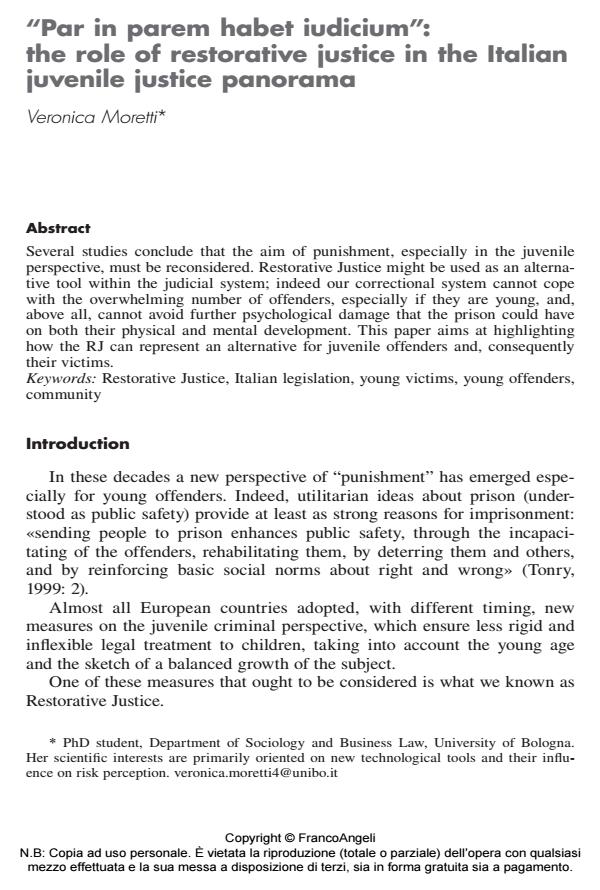"Par in parem habet iudicium": the role of restorative justice in the Italian juvenile justice panorama
Journal title SICUREZZA E SCIENZE SOCIALI
Author/s Veronica Moretti
Publishing Year 2015 Issue 2015/2
Language English Pages 8 P. 135-142 File size 80 KB
DOI 10.3280/SISS2015-002010
DOI is like a bar code for intellectual property: to have more infomation
click here
Below, you can see the article first page
If you want to buy this article in PDF format, you can do it, following the instructions to buy download credits

FrancoAngeli is member of Publishers International Linking Association, Inc (PILA), a not-for-profit association which run the CrossRef service enabling links to and from online scholarly content.
Several studies conclude that the aim of punishment, especially in the juvenile perspective, must be reconsidered. Restorative Justice might be used as an alternative tool within the judicial system; indeed our correctional system cannot cope with the overwhelming number of offenders, especially if they are young, and, above all, cannot avoid further psychological damage that the prison could have on both their physical and mental development. This paper aims at highlighting how the RJ can represent an alternative for juvenile offenders and, consequently their victims.
Keywords: Restorative Justice, Italian legislation, young victims, young offenders, community
- Bauman Z. (2000). Social issues of law and order. British Journal of Criminology, 40: 205-221. DOI: 10.1093/bjc/40.2.205
- Braithwaite J. (2002). Restorative Justice and Responsive Regulation. New York: Oxford University Press Braithwaite J. (2004). Restorative Justice and De-Professionalization. The Good Society, 13(1): 28-31. DOI: 10.1353/gso.2004.0023
- Elias N. (1978). The History of Manners: The Civilising Process. Oxford: Basil Blackwell.
- Foucault M. (1975). Surveiller et punir. Naissance de la prison. Parigi: Gallimard.
- Gal T. (2011). Juvenile Victims in Restorative Justice Findings from the Reintegrative Shaming Experiments. British Journal of Criminology, 51(6): 1014-1034. DOI: 10.1093/bjc/azr052
- Giacca F. (2004). La mediazione penale minorile, una risorsa o una reale alternativa? Telematic Journal of Clinical Criminology, 1-6.
- Halstead S. (1999). Educational Discipline using the Principles of Restorative Justice. Restorative Justice online, 1-15.
- Lawson C.L., Katz J. (2004). Restorative Justice: an alternative approach to juvenile crime. The Journal of Socio-economics, 33: 175-188. DOI: 10.1016/j.socec.2003.12.018
- Liebling A. (1993). Suicides in young prisoners: A summary. Death Studies, 17(5): 381-407. DOI: 10.1080/07481189308253385
- Meringolo P. (2012). Juvenile justice system in Italy: Researches and interventions. Universitas Psychologica, 11(4): 1081-1092.
- Ridolfi L. (2011). Il Community care quale possibile modello di integrazione sociosanitaria a livello territoriale. Paper for the Espanet Conference “Innovare il welfare. Percorsi di trasformazione in Italia e in Europa” Milano, September 29 - October 1.
- Strang H. (2003). Reparing the Harm: victims and restorative Justice. Utah Law Review, 15(1): 15-42.
- Tonry M., Petersilia J. (1999). Prisons Research at the Beginning of the 21st Century. Crime and Justice: A Review of Research, 26: 1-12.
- Vanfraechem I. (2007). Community, society and state in restorative justice: an exploration. In: Mackay R., Bosnjak M., Deklerck J., Pelikan C., van Stokkom
- B., Wright M., eds., Images of Restorative Justice Theory. Frankfurt, Verlag fur Polizeiwissenschaft, 73-91.
- Vezzadini S. (2006). La vittima di reato tra negazione riconoscimento. Bologna: Clueb.
- Zedner L. (2009). Security. New York: Routledge.
Veronica Moretti, "Par in parem habet iudicium": the role of restorative justice in the Italian juvenile justice panorama in "SICUREZZA E SCIENZE SOCIALI" 2/2015, pp 135-142, DOI: 10.3280/SISS2015-002010